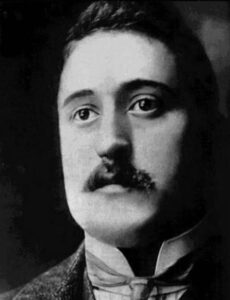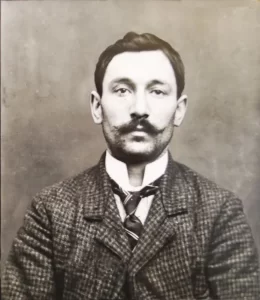 On August 21, 1911, the Mona Lisa was stolen from the Louvre Museum in Paris, in what seemed like an impossible scenario. The theft of the Mona Lisa was called “art heist of the century,” but it was actually pretty basic. A small, mustached man entered the Louvre Museum in Paris, on the evening of Sunday, August 20, 1911, and made his way to the Salon Carré, where the Da Vinci painting was housed alongside several other masterworks. Maybe the museum didn’t think a theft could happen to them, it’s hard to say, but security in the museum was lax, so the man found it easy to stow away inside a storage closet. He remained hidden there until the following morning when the Louvre was closed, and there were few people around. He saw his chance to escape at around 7:15 am. He put on one of the white aprons worn by the museum’s employees. Then after checking to see if the coast was clear, he walked up to the Mona Lisa, took if off of the wall and carried it to a nearby service stairwell. There he removed it from the frame and tried to exit the stairwell into a courtyard. The door was locked, so he placed the Mona Lisa, which he had wrapped in a white sheet, on the floor and tried to take apart the doorknob. That got him nowhere, but an unsuspecting Louvre employee
On August 21, 1911, the Mona Lisa was stolen from the Louvre Museum in Paris, in what seemed like an impossible scenario. The theft of the Mona Lisa was called “art heist of the century,” but it was actually pretty basic. A small, mustached man entered the Louvre Museum in Paris, on the evening of Sunday, August 20, 1911, and made his way to the Salon Carré, where the Da Vinci painting was housed alongside several other masterworks. Maybe the museum didn’t think a theft could happen to them, it’s hard to say, but security in the museum was lax, so the man found it easy to stow away inside a storage closet. He remained hidden there until the following morning when the Louvre was closed, and there were few people around. He saw his chance to escape at around 7:15 am. He put on one of the white aprons worn by the museum’s employees. Then after checking to see if the coast was clear, he walked up to the Mona Lisa, took if off of the wall and carried it to a nearby service stairwell. There he removed it from the frame and tried to exit the stairwell into a courtyard. The door was locked, so he placed the Mona Lisa, which he had wrapped in a white sheet, on the floor and tried to take apart the doorknob. That got him nowhere, but an unsuspecting Louvre employee  thought he was one of the Louvre’s plumbers, opened the door and let him out. He thanked the man and walked away.
thought he was one of the Louvre’s plumbers, opened the door and let him out. He thanked the man and walked away.
Then on September 7, 1911, came a shocking arrest. French poet Guillaume Apollinaire was jailed on suspicion of stealing Leonardo da Vinci’s Mona Lisa from the Louvre Museum in Paris. Apollinaire was a 31-year-old poet, who was known for his radical views and support for “extreme avant-garde” art movements, but his origins were shrouded in mystery. These days, it is believed that he was born in Rome and raised in Italy. At age 20, He moved to Paris and quickly blended in with the city’s bohemian crowd. His first volume of poetry, The Rotting Magician, appeared in 1909, followed by a story collection in 1910. Apollinaire was a supporter of Cubism, he published a book about the subject, Cubist Painters, in 1913. Cubism is “a revolutionary style of visual art invented by Pablo Picasso and Georges Braque in the early 20th century1. It is an influential modernist art movement that emerged in Paris, characterized by the transformation of objects and subjects  into geometric shapes, often resembling cubes or facets.” The same year, he published his most esteemed work, Alcools, where he used a variety of poetic forms and traditions to capture everyday street speech. His experimental play The Breasts of Tiresias was produced in 1917, for which he coined the term “surrealist.”
into geometric shapes, often resembling cubes or facets.” The same year, he published his most esteemed work, Alcools, where he used a variety of poetic forms and traditions to capture everyday street speech. His experimental play The Breasts of Tiresias was produced in 1917, for which he coined the term “surrealist.”
His poetic works were inspirational, but Apollinaire’s mysterious background and radical views led authorities to view him as a dangerous foreigner and therefore a prime suspect in the Mona Lisa heist. Still with all their searching, they could find no evidence that linked Apollinaire to the theft. Apollinaire was released after five days. It seemed that the Mona Lisa, which is today valued at about 1 billion dollars, was lost forever. Then two years later, a former employee of the Louvre, Vincenzo Peruggia, was arrested while trying to sell the famous painting to an art dealer. He had been the bold thief and Apollinaire had simply been wrongfully accused.


Leave a Reply